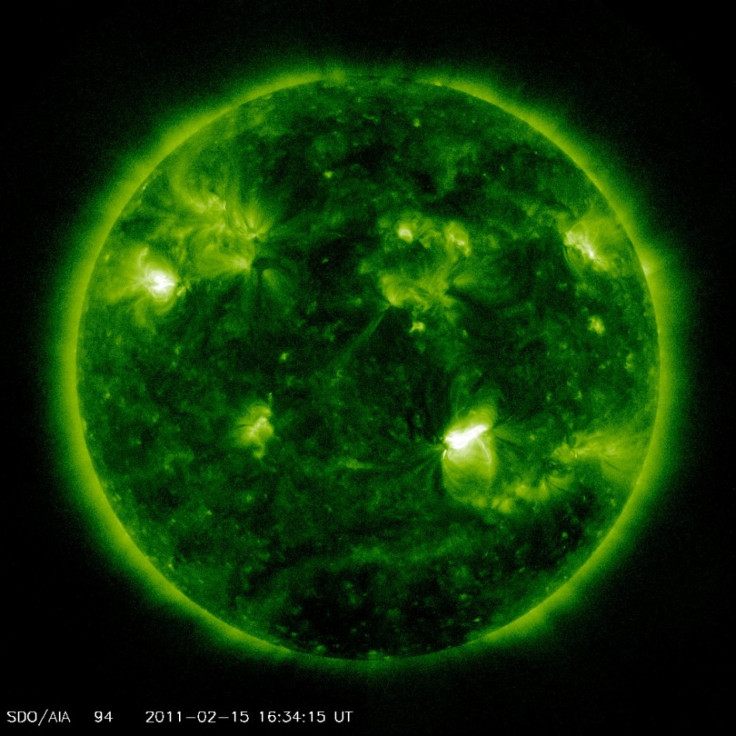Solar Flare Could Cause Auroras, Radio Interference

The strongest solar flares seen in several years are sending a mass of charged particles towards the Earth, which could cause radio interference and auroral displays.
The flare first erupted on Feb. 13, from a sunspot numbered 1158, and grew again on Monday night at about 9 p.m. Eastern time. It is pointed directly at the Earth, and will send X-rays and charged particles towards the planet. It was picked up by NASA's Solar Dynamics Observatory. Another erupted on Feb. 14 at about 9 p.m. Eastern time.
The flares were accompanied by a coronal mass ejection, or CME, which is a cloud of hot charged particles that moves at high speed outward from the Sun's surface. The flares are seen first, as the light and radiation take only eight minutes to get to Earth. The CME moves slower and takes days, in the same way that thunder follows lightning.
Joe Kunches, space scientist at the National Oceanic and Atmospheric Administration, said the disturbances in the magnetic field should appear over the course of the next 24 hours. While the current flares are energetic, they aren't as violent as ones recorded in 2003, when satellite communications were affected. Kunches said the most noticeable effect might be on the GPS satellites. As a precaution, many airlines are re-routing flights around the North Pole to stay far south enough that they are in the line of sight of the satellites they use to communicate with ground stations.
The British Geological Survey said it has received reports of the Northern Lights showing up in Northern Ireland. They are especially visible if the sky is dark and the activity peaks at night. Kunches noted that the moon is nearly full, so unless an aurora is particularly bright it will be very difficult to see.
Solar flares happen because the Sun's magnetic field is a complicated shape. Earth's field is like a giant bar magnet, with a north and south pole and neat lines describing a spherical shape with a large indentation at either end.
The sun, however, is made of hot gases that are highly energetic, called plasmas. The gas forms convection cells, which are regions where hotter gas is rising and cooler gas falls towards the Sun's center. As that happens the plasmas, which are made up of charged particles, create their own magnetic fields. Instead of a giant neat toroid, the Sun's magnetic fields are knotty and tangled.
The plasma follows the field lines, forming the loops visible in images of the Sun's surface. Sometimes those lines can cross. A lot of energy can be stored in the magnetic fields, and when one touches another it can release that energy, forming a flare.
Flares send bursts of X-rays and charged particles -- mostly protons -- out from the Sun's surface into space. Occasionally one is pointed towards the Earth. They are classified according to how powerful they are, as A, B, C, M or X, with X being the most powerful. The flare SDO detected was an M-class flare on Feb. 13, but the next one was an X-class flare.
The last big solar flare occurred in 2006, and more powerful ones have occurred in 2005 and 2003 as well. The most powerful ever recorded was in 1859 and was sufficiently strong to damage electrical equipment (at the time, telegraph cables).
Kunches notes that even powerful flares are probably not catastrophic events, as a lot of the equipment affected by flares is built with the possibility of magnetic storms in mind. The engineers that make these things, like satellites, they know a lot about the environment up there, he said. They aren't stupid. While a major magnetic storm might cause some disruptions - satellite radio stations were affected by the 2003 events, for instance -- it won't necessarily do much damage, he said.
NASA has released a video of the flare, compiled from spacecraft images.
To contact the reporter responsible for this story call (646) 461 6917 or email j.emspak@ibtimes.com.
© Copyright IBTimes 2024. All rights reserved.




















